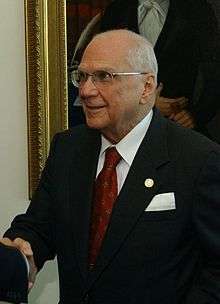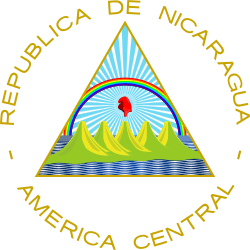Enrique Bolaños
Enrique José Bolaños Geyer (born May 13, 1929)[2] is a Nicaraguan former politician who served as President of Nicaragua from January 10, 2002 to January 10, 2007. He received his education in the United States, graduating with a bachelor's degree in Industrial Engineering from Saint Louis University in 1962.
Enrique Bolaños Geyer | |
|---|---|
 Bolaños in 2004 | |
| President of Nicaragua | |
| In office January 10, 2002 – January 10, 2007 | |
| Vice President | José Rizo Castellón (2002-2005) Alfredo Gómez Urcuyo (2005-2007) |
| Preceded by | Arnoldo Alemán |
| Succeeded by | Daniel Ortega |
| Vice President of Nicaragua | |
| In office January 10, 1997 – October 24, 2000 | |
| President | Arnoldo Alemán |
| Preceded by | Julia Mena |
| Succeeded by | Leopoldo Navarro Bermúdez |
| Personal details | |
| Born | May 13, 1929 Masaya, Nicaragua |
| Political party | Constitutionalist Liberal Party[1] Alliance for the Republic |
| Spouse(s) | Lila Abaunza (deceased) |
| Children | 5 |
| Alma mater | Saint Louis University |
Bolaños served as vice president under his predecessor, Arnoldo Alemán. On November 4, 2001 he defeated Daniel Ortega of the Sandinista National Liberation Front party in the presidential elections and was sworn in as president on January 10, 2002. He was a member of the Constitutional Liberal Party (PLC) until he broke with it to help form the Alliance for the Republic (APRE). At the beginning of his term, he led an anti-Corruption campaign against his predecessor and the head of the PLC Arnoldo Alemán.
Early life and career
Bolaños was born in Masaya on May 13, 1929. He received his primary and secondary education in Nicaragua at the Colegio Centro América, and graduated from Saint Louis University with a degree in industrial engineering. He married Lila T. Abaúnza in 1949.[3]
In 1952 he began a successful agro-production company, SAIMSA (Industrial Agricultural Services of Masaya), which grew to become one of the largest cotton producers in Central America.[4] Bolaños served as an active member of the influential COSEP (Supreme Council for Private Enterprise), and served as president from 1983 to 1988.[5] COSEP was an anti-Sandinista institution that focused on promoting free enterprise and limiting governmental interference in the private sector.
Bolaños publicly opposed Daniel Ortega's Sandinista government during the 1980s. He was arrested on October 20, 1981 for having violated censorship laws. One month later he was imprisoned again upon returning from an AIL (Association of Latin American Enterprises) conference in Venezuela.[6] In July 1982 he was jailed after sponsoring a conference of potential American investors at his cotton plantation in Masaya. Under the government's controversial agrarian reform program SAIMSA was confiscated and reappropriated to small farmers. Bolanos characterized the confiscation as a reprisal for his political activities.[7]
In 1996 Bolaños was chosen by presidential candidate and former mayor of Managua Arnoldo Alemán as vice-presidential candidate for the PLC (Liberal Constitutionalist Party). Bolaños was also elected as campaign manager for the Liberal Party in the 1996 elections. Alemán defeated Ortega with 51% of the vote, and Alemán and Bolaños were sworn in as president and vice president, respectively, on January 10, 1997.[8]
Presidency (2002–2007)
| Presidential styles of Enrique Bolaños | |
|---|---|
 | |
| Reference style | El Honorable Enrique Bolaños, Presidente de la República de Nicaragua The Honorable Enrique Bolanos, President of the Republic of Nicaragua |
| Spoken style | Presidente Bolaños President Bolanos |
| Alternative style | Señor Presidente Mister President |
Bolaños was chosen as the presidential candidate for the 2001 elections at the Grand Convention of the Constitutionalist Liberal Party (PLC) meeting in 2001. Bolaños won the presidential elections with 56.3% of the vote, Daniel Ortega received 42.3% and Conservative Party candidate Alberto Saborio received 1.4%.
Bolaños was sworn in as President of the Republic of Nicaragua on January 10, 2002 to serve a five-year term (2002–2007).[1] Two days later, he began an anti-corruption campaign to investigate and prosecute all former and current state employees who engaged in corrupt behavior. In September 2005 Bolaños publicly announced what he called a “slow motion coup” by the joint efforts of the PLC and the FSLN. The executive branch was partially stripped of its powers to appoint ministers and public officials, but with backing from the international community, particularly the OAS, the EU and the United States, any constitutional changes were postponed until the following year . This reversal coincided with passage of the CAFTA by the Nicaraguan legislature .
In the 2006 presidential election campaign Bolaños' Alliance for the Republic party joined the Nicaraguan Liberal Alliance, whose candidate Eduardo Montealegre took second place. Bolaños turned over the presidency to his longtime political opponent Daniel Ortega on January 10, 2007. By nature of his status as outgoing President, he was legally entitled to a seat in the new session of the National Assembly, but has since remained out of the political arena and never assumed his seat. Bolaños ordered the compilation of a list of public officials "suspected" of being part of the "gay-lesbian world".[9] In November 2006, abortion was totally prohibited and he suggested fixing the condemnations to 30 years of prison.[10]
Post-presidency: Enrique Bolaños Foundation
Following his presidency, Bolaños retired from politics. He currently runs a non-profit educational foundation[11] that provides free and democratic access to all documents from Bolaños' presidency as well as many digitized collections of Nicaraguan historical, political, cultural and juridical documents. It is the first Nicaraguan presidential library, and one of Latin America's first virtual presidential libraries. The Foundation's goal is to collect, preserve and disseminate Nicaragua's historical patrimony to promote transparency in the Nicaraguan political sector and provide free, unrestricted access to information. The foundation's mission is to give all citizens equal access to verifiable information in hopes of mitigating educational inequalities in Nicaragua.
Electoral history of Enrique Bolaños Geyer
Vice Presidential election results, October 20, 1996
| Candidate | Party/Alliance | Votes | % |
|---|---|---|---|
| José Arnoldo Alemán Lacayo w Enrique Bolaños Geyer | Liberal Alliance (AL) = Constitutionalist Liberal Party (PLC) / Independent Liberal Party for National Unity (PLIUN) / Nationalist Liberal Party (PLN) / Neoliberal Party (PALI) | 896,207 | 50.99% |
| José Daniel Ortega Saavedra w Juan Manuel Caldera | Sandinista National Liberation Front (FSLN) | 664,909 | 37.83% |
| Others | 21 Political Partis | 196,659 | 11.18% |
| Total valid votes | 1,757,775 | 100% | |
| Spoilt and invalid votes | 91,587 | 04.95% | |
| Total votes/Turnout | 1,849,362 | 76.39% | |
| Registered voters | 2,421,067 | – | |
| Population | 4,706,000 | – | |
National Convention of the Constitutionalist Liberal Party (PLC) presidential primaries,[12] January 28, 2001
- Enrique Bolaños Geyer – 220 (54.6%)
- Eduardo Montealegre – 143 (35.5%)
- Iván Escobar Fornos – 38 (9.4%)
- Null – 2 (0.5%)
Presidential election results, November 4, 2001
| Candidate | Party/Alliance | Votes | % |
|---|---|---|---|
| Enrique Bolaños Geyer | Constitutionalist Liberal Party (PLC) | 1,228,412 | 56.31% |
| José Daniel Ortega Saavedra | Sandinista National Liberation Front (FSLN) | 922,436 | 42.28% |
| Alberto Saborío | Conservative Party of Nicaragua (PC) | 30,670 | 01.41% |
| Total valid votes | 100% | 2,181,518 | |
References
- "Gobernantes de Nicaragua". Ministerio de Educación. 9 December 2012. Archived from the original on 9 October 2012.
- Profile of Enrique Bolaños
- "Lila Abaunza, former Nicaraguan first lady, dies at 79". Associated Press. International Herald Tribune. 2008-07-19. Retrieved 2008-07-25.
- Paige, Jeffery M. (1998). Coffee and Power: Revolution and the Rise of Democracy in Central America. Harvard University Press. ISBN 9780674136496.
- Rostrán, Carlos. "Ex-Presidentes". www.cosep.org.ni (in Spanish). Retrieved 2018-06-07.
- EFE (2001-11-06). "Enrique Bolaños, un empresario de 73 años en la presidencia de Nicaragua". El País (in Spanish). ISSN 1134-6582. Retrieved 2018-06-07.
- Times, Stephen Kinzer and Special To the New York. "SANDINISTAS SEIZE LAND OF A CRITIC". Retrieved 2018-06-07.
- History of Vicepresidency Archived October 25, 2008, at the Wayback Machine
- https://doc.es.amnesty.org/cgi-bin/ai/BRSCGI/Texto%20completo%20del%20Informe?CMD=VEROBJ&MLKOB=24790052323%5B%5D
- http://www.mujeresenred.net/spip.php?article808
- "Biblioteca Enrique Bolaños". www.enriquebolanos.org. Retrieved 2020-04-10.
- http://www.enriquebolanos.org/camino_presidencia.cfm?UID=1&UIID=6&UIIID=34&cap=10&search=sub01#2
External links
- Biography and tenure by CIDOB Foundation (in Spanish)
| Political offices | ||
|---|---|---|
| Preceded by Julia Mena |
Vice President of Nicaragua 1997–2000 |
Succeeded by Leopoldo Navarro |
| Preceded by Arnoldo Alemán |
President of Nicaragua January 10, 2002 – January 10, 2007 |
Succeeded by Daniel Ortega |